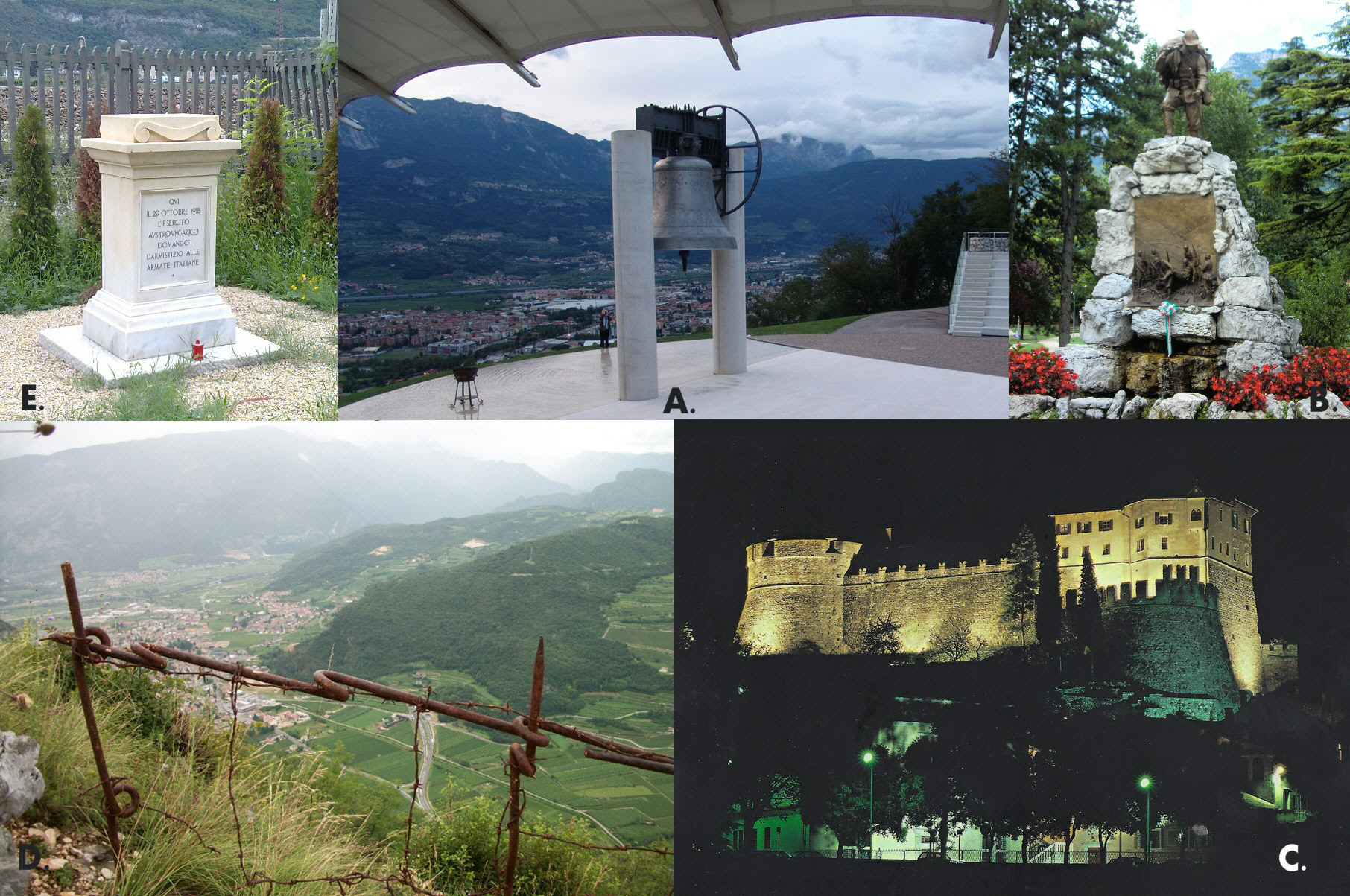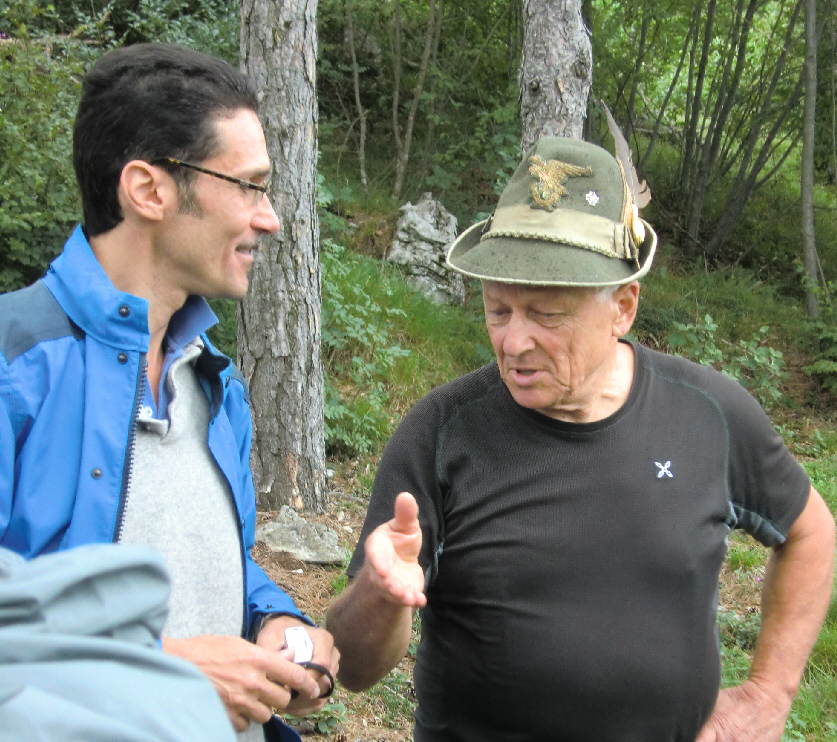Click on Image to Expand
Rovereto: At the Heart of the Italian Front
Rovereto in the Italian Trentino was once an ancient fortress town standing at the frontier between Trento and the Republic of Venice, on the route leading south from the Brenner Pass through the Alps. It stood just inside the Austrian Tyrol when war came with Italy in 1915. Hostilities broke out nearby in the fortress zone east of the city and ended with the Austrian appeal for an armistice at the front line, just south of the city. Rovereto's magnificent setting holds a remarkable number of sites of interest to military history enthusiasts. A selection (not all) are shown in the photo above:
A. On Miraville Hill overlooking the city and the Adige River valley is the "Maria Dolens" bell. Made from the war's cannons, it tolls 100 times every evening at sundown in a ceremony that is the Italian Front's equivalent to the Last Post ceremony at the Menin Gate.
B. In the center city is the national monument to Italy's elite mountain warriors, the Alpini, who bore the brunt of the "High War" in the surrounding mountains.
C. Towering over the city's center is the Castello di Rovereto, which, since 1921, has housed Italy's national war museum, the Museo Storico Italiano della Guerra. The wonderful collection includes displays remembering all the participants in the Great War, unique items on the mountain war, and an especially good display of artillery pieces in an adjacent site.
D. Above the city, accessible by auto and by (usually) short walks, are a number of trenches, observation posts, and artillery positions of both sides. Shown here is the view from the Austro-Hungarian fortified position at Nagia Grom on the opposite side of the river from Rovereto.
E. Just south of the city is the marker commemorating the site where Austria-Hungary formally requested an armistice on 29 October 1918.
| Thanks to Robbie Patriagni, who guided me on both my visits to Rovereto and Trento and helped make my 2011 Italian Front tour a success. |
Robbie and an Alpini Veteran at Nagia Grom |



l caposaldo del monte Nagià Grom venne costruito a partire dalla primavera del 1915, ma subì ampliamenti e modifiche per tutta la durata della guerra.Venne realizzato come parte integrante del sistema fortificato campale a difesa del territorio compreso tra Riva del Garda e la Vallagarina:permetteva infatti di sorvegliare gli accessi alla Val di Gresta dalla Valle di Loppio e dalla Vallagarina. Assieme al vicino monte Faé rappresentava il perno della linea difensiva del “sottosettore 4a” (monte Biaena); con le postazioni “Costa” e “San Rocco” formava un “gruppo di combattimento” (Kampfgruppe) autonomo, dotato di 4 mitragliatrici, due cannoni da 9 cm M.75/96 e due cannoni da montagna da 7,5 cm M.15. Erano presenti lanciamine (Minenwerfer) ed un riflettore da 60 cm.Nell’estate del 1915 il caposaldo era presidiato da un plotone di fanteria (cinquanta soldati al comando di un cadetto aspirante ufficiale) e da un distaccamento d’artiglieria. Nel 1916 la guarnigione raggiunse la forza di tre plotoni al comando di un capitano, rafforzati con una parte del battaglioneStandschützen “Kitzbühel” (l’altra parte era sul monte Faé).Il caposaldo era in grado di difendersi da tentativi di aggiramento e costituiva un complesso piuttosto articolato, organizzato in modo da garantire al presidio militare la massima autonomia possibile.Sulla sommità venne scavata una trincea perimetrale che garantiva una difesa a 360°, suddivisa in postazioni di combattimento numerate in cifre romane da I a XIV.Dalla trincea sommitale, dalle postazioni d’artiglieria in caverna o all’aperto e dagli osservatori, partivano i camminamenti che assicuravano un collegamento protetto con i servizi situati nel cuore della fortificazione. Attraverso questi passaggi si compiva il rito quotidiano del cambio delle truppe di presidio alle trincee come pure il servizio di rifornimento dal deposito delle munizioni.In posizione defilata dal tiro delle artiglierie nemiche erano collocati i centri vitali del caposaldo:baraccamenti per l’alloggio degli ufficiali, delle truppe e degli operai militarizzati, magazzini di materiali, un cisterna da campo ed una cucina dotata di un ampio magazzino viveri.Queste trincee sono visitabili grazie al lavoro di ripristino, fatto dal gruppo Alpini "Remo Rizzardi" di Mori. Visitate il sito web: http://www.anamori.org/trinceenagiagrom
ReplyDeleteCommentary Above Translated, From Italian to English
ReplyDeleteThe Nagia Grom STRONGHOLD
The stronghold of the mountain Nagià Grom was built starting in the spring of 1915, and underwent expansions and modifications all along the wartime . It was designed as an integral part of the fortified system aimed to defend the territory between Riva del Garda and Vallagarina: allowing in fact, to monitor accesses to the Gresta Valley from the Valley of Loppio and Vallagarina. Together with the nearby Mount Faé, it was the pivot of the defensive line of the "sub-section 4a" (Mt Biaena), with positions "Coast" and "San Rocco". It formed an independent, "battle group" (Kampfgruppe) with 4 machine guns, two 9 cm M.75/96 guns and two mountain guns 7.5 cm M.15. Were present mine-throwers (Minenwerfer) and a reflector 60 cm. During the summer of 1915 the stronghold was manned by an infantry platoon (fifty soldiers under the command of a cadet officer) and a detachment of artillery.
In 1916 the garrison reached the strength of three platoons under the command of a captain, strengthened with a piece of battalion Standschützen "Kitzbühel" (the other part was on the mountain Faé.) The stronghold was able to defend itself from outflanking attempts, and this constituted quite impressive complex, organized so as to ensure maximum possible autonomy to the military garrison. On its summit was dug a trench perimeter which provided a defense to 360 degrees, divided into fighting positions numbered from I to XIV. From the summit, surrounded by artillery in underground placements or open air placements and observation posts , started the trenches that ensured a secure connection with the services located in the heart of the fortification. Through these passages the daily ritual of the rotating the troops of the garrison in the trenches as well as the service of the ammunition supply took place .In positions hid from direct fire by the enemy artillery were placed the vital areas: barracks for the accommodation of officers, troops and militarized workers, warehouses of materials, a water tank, and a field kitchen with a large warehouse of rations.
All the remaining of such trenches can be visited thanks to the work of restoration, made by Alpine Group "Remo Rizzardi" Mori. Visit their website at:
http://www.anamori.org/trinceenagiagrom
Translated by Roberto PATRIGNANI rpatrignani@hotmail.com